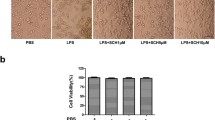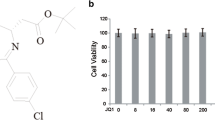Abstract
Neuroinflammation is an important pathological feature in neurodegenerative diseases. Accumulating evidence has suggested that neuroinflammation is mainly aggravated by activated microglia, which are macrophage like cells in the central nervous system. Therefore, the inhibition of microglial activation may be considered for treating neuroinflammatory diseases. p38 mitogen-activated protein kinase (MAPK) has been identified as a crucial enzyme with inflammatory roles in several immune cells, and its activation also relates to neuroinflammation. Considering the proinflammatory roles of p38 MAPK, its inhibitors can be potential therapeutic agents for neurodegenerative diseases relating to neuroinflammation initiated by microglia activation. This study was designed to evaluate whether NJK14047, a recently identified novel and selective p38 MAPK inhibitor, could modulate microglia-mediated neuroinflammation by utilizing lipopolysaccharide (LPS)-stimulated BV2 cells and an LPS-injected mice model. Our results showed that NJK14047 markedly reduced the production of nitric oxide and prostaglandin E2 by downregulating the expression of various proinflammatory mediators such as nitric oxide synthase, cyclooxygenase-2, tumor necrosis factor-α and interleukin-1β in LPS-induced BV2 microglia. Moreover, NJK14047 significantly reduced microglial activation in the brains of LPS-injected mice. Overall, these results suggest that NJK14047 significantly reduces neuroinflammation in cellular/vivo model and would be a therapeutic candidate for various neuroinflammatory diseases.




Similar content being viewed by others
References
Biber K, Moller T, Boddeke E, Prinz M (2016) Central nervous system myeloid cells as drug targets: current status and translational challenges. Nat Rev Drug Discov 15:110–124
Cunningham CL, Martinez-Cerdeno V, Noctor SC (2013) Microglia regulate the number of neural precursor cells in the developing cerebral cortex. J Neurosci 33:4216–4233
Ueno M, Fujita Y, Tanaka T, Nakamura Y, Kikuta J, Ishii M, Yamashita T (2013) Layer V cortical neurons require microglial support for survival during postnatal development. Nat Neurosci 16:543–551
Zhan Y, Paolicelli RC, Sforazzini F, Weinhard L, Bolasco G, Pagani F, Vyssotski AL, Bifone A, Gozzi A, Ragozzino D, Gross CT (2014) Deficient neuron-microglia signaling results in impaired functional brain connectivity and social behavior. Nat Neurosci 17:400–406
Block ML, Zecca L, Hong JS (2007) Microglia-mediated neurotoxicity: uncovering the molecular mechanisms. Nat Rev Neurosci 8:57–69
Kaminska B (2005) MAPK signalling pathways as molecular targets for anti-inflammatory therapy—from molecular mechanisms to therapeutic benefits. Biochim Biophys Acta 1754:253–262
Witcher KG, Eiferman DS, Godbout JP (2015) Priming the inflammatory pump of the CNS after traumatic brain injury. Trends Neurosci 38:609–620
Norden DM, Godbout JP (2013) Review: microglia of the aged brain: primed to be activated and resistant to regulation. Neuropathol Appl Neurobiol 39:19–34
Kim EK, Choi EJ (2015) Compromised MAPK signaling in human diseases: an update. Arch Toxicol 89:867–882
Perry VH, Holmes C (2014) Microglial priming in neurodegenerative disease. Nat Rev Neurol 10:217–224
Bodea LG, Wang Y, Linnartz-Gerlach B, Kopatz J, Sinkkonen L, Musgrove R, Kaoma T, Muller A, Vallar L, Di Monte DA, Balling R, Neumann H (2014) Neurodegeneration by activation of the microglial complement-phagosome pathway. J Neurosci 34:8546–8556
Fan K, Li D, Zhang Y, Han C, Liang J, Hou C, Xiao H, Ikenaka K, Ma J (2015) The induction of neuronal death by up-regulated microglial cathepsin H in LPS-induced neuroinflammation. J Neuroinflammation 12:54
Henry CJ, Huang Y, Wynne AM, Godbout JP (2009) Peripheral lipopolysaccharide (LPS) challenge promotes microglial hyperactivity in aged mice that is associated with exaggerated induction of both pro-inflammatory IL-1beta and anti-inflammatory IL-10 cytokines. Brain Behav Immun 23:309–317
Dutta G, Zhang P, Liu B (2008) The lipopolysaccharide Parkinson’s disease animal model: mechanistic studies and drug discovery. Fundam Clin Pharmacol 22:453–464
Kaneko YS, Mori K, Nakashima A, Sawada M, Nagatsu I, Ota A (2005) Peripheral injection of lipopolysaccharide enhances expression of inflammatory cytokines in murine locus coeruleus: possible role of increased norepinephrine turnover. J Neurochem 94:393–404
Lund S, Christensen KV, Hedtjarn M, Mortensen AL, Hagberg H, Falsig J, Hasseldam H, Schrattenholz A, Porzgen P, Leist M (2006) The dynamics of the LPS triggered inflammatory response of murine microglia under different culture and in vivo conditions. J Neuroimmunol 180:71–87
Pearson G, Robinson F, Gibson BT, Xu BE, Karandikar M, Berman K, Cobb MH (2001) Mitogen-activated protein (MAP) kinase pathways: regulation and physiological functions. Endocr Rev 22:153–183
Escos A, Risco A, Alsina-Beauchamp D, Cuenda A (2016) p38gamma and p38delta mitogen activated protein kinases (MAPKs), new stars in the MAPK galaxy. Front Cell Dev Biol 4:31
Yokota T, Wang Y (2016) p38 MAP kinases in the heart. Gene 575:369–376
Arthur JS, Ley SC (2013) Mitogen-activated protein kinases in innate immunity. Nat Rev Immunol 13:679–692
Denise Martin E, De Nicola GF, Marber MS (2012) New therapeutic targets in cardiology: p38 alpha mitogen-activated protein kinase for ischemic heart disease. Circulation 126:357–368
Lee JK, Kim NJ (2017) Recent advances in the inhibition of p38 MAPK as a potential strategy for the treatment of Alzheimer’s disease. Molecules 22(8):E1287
Heo J, Shin H, Lee J, Kim T, Inn KS, Kim NJ (2015) Synthesis and biological evaluation of N-cyclopropylbenzamide-benzophenone hybrids as novel and selective p38 mitogen activated protein kinase (MAPK) inhibitors. Bioorganic Med Chem Lett 25:3694–3698
Choi MS, Heo J, Yi CM, Ban J, Lee NJ, Lee NR, Kim SW, Kim NJ, Inn KS (2016) A novel p38 mitogen activated protein kinase (MAPK) specific inhibitor suppresses respiratory syncytial virus and influenza A virus replication by inhibiting virus-induced p38 MAPK activation. Biochem Biophys Res Commun 477:311–316
Hwang DS, Gu PS, Kim N, Jang YP, Oh MS (2018) Effects of Rhei Undulati Rhizoma on lipopolysaccharide-induced neuroinflammation in vitro and in vivo. Environ Toxicol 33:23–31
Lee JK, Jin HK, Bae JS (2010) Bone marrow-derived mesenchymal stem cells attenuate amyloid beta-induced memory impairment and apoptosis by inhibiting neuronal cell death. Curr Alzheimer Res 7:540–548
Kim SY, Kim H, Kim SW, Lee NR, Yi CM, Heo J, Kim BJ, Kim NJ, Inn KS (2017) An effective antiviral approach targeting hepatitis B virus with NJK14047, a novel and selective biphenyl amide p38 mitogen-activated protein kinase inhibitor. Antimicrob Agents Chemother 61(8):e00214–e00217
Wang J, Chen L, Liang Z, Li Y, Yuan F, Liu J, Tian Y, Hao Z, Zhou F, Liu X, Cao Y, Zheng Y, Li Q (2017) Genipin inhibits LPS-induced inflammatory response in BV2 microglial cells. Neurochem Res 42:2769–2776
Benicky J, Sanchez-Lemus E, Honda M, Pang T, Orecna M, Wang J, Leng Y, Chuang DM, Saavedra JM (2011) Angiotensin II AT1 receptor blockade ameliorates brain inflammation. Neuropsychopharmacol 36:857–870
Henry CJ, Huang Y, Wynne A, Hanke M, Himler J, Bailey MT, Sheridan JF, Godbout JP (2008) Minocycline attenuates lipopolysaccharide (LPS)-induced neuroinflammation, sickness behavior, and anhedonia. J Neuroinflammation 5:15
Ransohoff RM, Brown MA (2012) Innate immunity in the central nervous system. J Clin Investig 122:1164–1171
Chao CC, Hu S, Molitor TW, Shaskan EG, Peterson PK (1992) Activated microglia mediate neuronal cell injury via a nitric oxide mechanism. J Immunol 149:2736–2741
Chinta SJ, Ganesan A, Reis-Rodrigues P, Lithgow GJ, Andersen JK (2013) Anti-inflammatory role of the isoflavone diadzein in lipopolysaccharide-stimulated microglia: implications for Parkinson’s disease. Neurotox Res 23:145–153
Kim SH, Smith CJ, Van Eldik LJ (2004) Importance of MAPK pathways for microglial pro-inflammatory cytokine IL-1 beta production. Neurobiol Aging 25:431–439
Acknowledgements
This research was supported by Basic Science Research Program through the National Research Foundation of Korea (NRF), which was funded by the Ministry of Science, ICT & Future Planning (NRF-2017R1A5A2014768 and NRF-2016R1A2B4015169).
Author information
Authors and Affiliations
Contributions
MSG and SYK performed the experiments, analyzed the data, and prepared the manuscript. NK and SJL performed animal and HPLC experiment, respectively. MSO, HKJ, JSB, KSI, NJK and JKL interpreted the data and reviewed the paper. NJK and JKL designed the study and wrote the manuscript. All authors discussed results and commented on the manuscript.
Corresponding authors
Ethics declarations
Conflict of interest
The authors declare no conflict of interest.
Electronic supplementary material
Below is the link to the electronic supplementary material.
Rights and permissions
About this article
Cite this article
Gee, M.S., Kim, SW., Kim, N. et al. A Novel and Selective p38 Mitogen-Activated Protein Kinase Inhibitor Attenuates LPS-Induced Neuroinflammation in BV2 Microglia and a Mouse Model. Neurochem Res 43, 2362–2371 (2018). https://doi.org/10.1007/s11064-018-2661-1
Received:
Revised:
Accepted:
Published:
Issue Date:
DOI: https://doi.org/10.1007/s11064-018-2661-1




